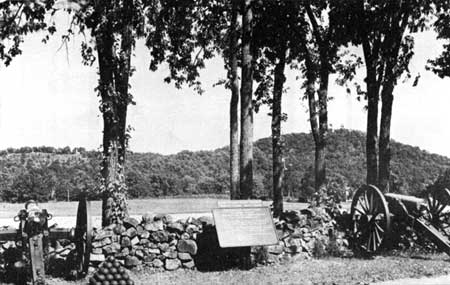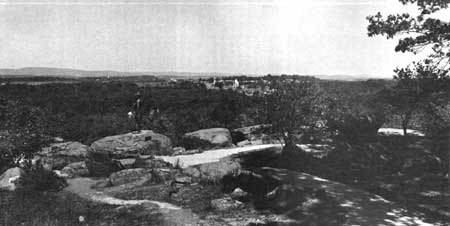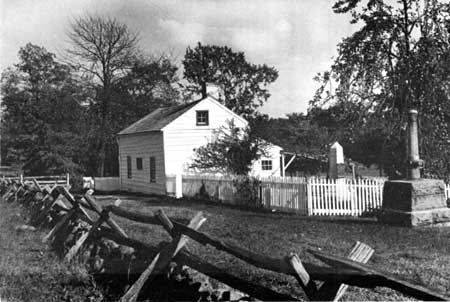|
GETTYSBURG National Military Park |
 |

The Round Tops as they appear from Longstreet's battle line one mile
away.
The Third Day (continued)
LEE AND MEADE SET THE STAGE. Late in the forenoon of July 3, General Meade had completed his plan of defense. Another Confederate attack could be expected: "Where?" was still the question. General Hunt, sensing the danger, placed a formidable line of batteries in position on the crest of Cemetery Ridge and alerted others in the rear for emergency use. As a final act of preparation, Meade inspected his front at the stone wall, then rode southward to Little Round Top. There, with General Warren, he could see the long lines of massed Confederate batteries, a sure indication of attack. Meade rode back to his headquarters.
Lee, on his part, had spent the forenoon organizing his attack formations on Seminary Ridge. Having reached his decision to strike the Union center, he had ordered the movement of batteries from the rear to points of advantage. By noon, about 140 guns were in line from the Peach Orchard northward to the Seminary buildings, many of them only 800 yards from the Union center. To Colonel Alexander fell the lot of directing the artillery fire and informing the infantry of the best opportunity to advance.
Massed to the west of Emmitsburg Road, on low ground which screened their position from the Union lines, lay Gen. George Pickett's three brigades commanded by Kemper, Armistead, and Garnett. Pickett's men had arrived the previous evening from Chambersburg, where they had guarded Lee's wagons on July 1 and 2. As a division these units had seen little fighting. Soon they would gain immortality. On Pickett's left, the attacking front was fast being organized. Joseph Pettigrew, a brigadier, was preparing to lead the division of the wounded Major General Heth, and Maj. Gen. Isaac Trimble took the command of Pender. Nearly 10,000 troops of these two divisions—including such units as the 26th North Carolina whose losses on the first day were so heavy that the dead marked their advance "with the accuracy of a line at a dress parade"—now awaited the order to attack. Many hours earlier, the Bliss farm buildings, which lay in their front, had been burned. Their objective on the ridge was in clear view. The brigades of Wilcox and Lang were to move forward on the right of Pickett in order to protect his flank as he neared the enemy position.

View northward from Little Round Top, statue of Gen. G. K. Warren
in foreground. The Pennsylvania Memorial, center, marks the crest of
Cemetery Ridge. Pickett's Charge came from the left across the open
fields.
General Stuart, in the meantime, had been out of touch with Lee. Moving northward on the right flank of the Union Army, he became involved in a sharp engagement at Hanover, Pa., on June 30. Seeking to regain contact with Lee, he arrived at Carlisle on the evening of July 1. As he began shelling the barracks, orders arrived from Lee and he at once marched for Gettysburg, arriving north of the town the next day.
Early on July 3 he was ordered to take position on the Confederate left. This movement usually has been interpreted as an integral part of Lee's assault plan. But battle reports leave Stuart's role vague, except for covering the Confederate left. Doubtless he would have exploited any significant success achieved by the infantry assault.

Meade's headquarters today.
Except for the intermittent sniping of sharpshooters, an ominous silence prevailed over the fields. The orders had now been given; the objective had been pointed our. Men talked of casual things. Some munched on hard bread, others looked fearfully to the eastward, where, with the same mixed feelings, lay their adversary.
Far to the south, on another crucial front, General Pemberton was penning a letter to General Grant asking terms for the surrender of Vicksburg. In Richmond, the sick and anxious Jefferson Davis looked hopefully for heartening word from his great field commander at Gettysburg. The outcome of this bold venture would count heavily in the balance for the cause of the Confederacy.

|

|
|
Last Modified: Mon, Mar 4 2002 10:00:00 pm PDT |


